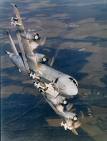|
Lockheed Martin P-3 Orion
 In February 1959, the Navy awarded Lockheed a contract to develop a replacement for the aging P2V Neptune. The P3V Orion, derived from Lockheed`s successful L 188 Electra airliner, entered the inventory in July 1962. It has gone through one designation change (P3V to P-3) and three major models: P-3A, P-3B, and P-3C. In February 1959, the Navy awarded Lockheed a contract to develop a replacement for the aging P2V Neptune. The P3V Orion, derived from Lockheed`s successful L 188 Electra airliner, entered the inventory in July 1962. It has gone through one designation change (P3V to P-3) and three major models: P-3A, P-3B, and P-3C.
The P-3C is a land-based, long-range, anti-submarine warfare (ASW) patrol aircraft. It has advanced submarine detection sensors such as directional frequency and ranging (DIFAR) sonobuoys and magnetic anomaly detection (MAD) equipment. The avionics system is integrated by a general purpose digital computer that supports all of the tactical displays, monitors and automatically launches ordnance and provides flight information to the pilots. In addition, the system coordinates navigation information and accepts sensor data inputs for tactical display and storage. The P-3C can carry a mixed payload of weapons internally and on wing pylons.
Specifications, P-3:
Engines: Four Allison T-56-A-14 turboprop engines (4,900 shaft horsepower each)
Weight, takeoff (lbs): 139,760
Wing Span (feet): 99`6
Length (feet): 116`7
Speed (mph): 411
Ceiling (feet): 28,300
Range (miles): 2,739
Armament: 20,000 pounds of ordnance including: Harpoon cruise missile, SLAM missiles, Maverick air-to-ground missiles, MK-46/50 torpedoes, rockets, mines, depth bombs, and special weapons.
Back to History Index
 |
Marshall Is. |
1998 |
P-3 Orion anti-submarine aircraft |
|